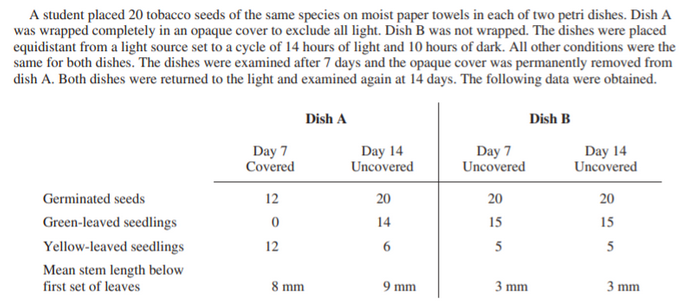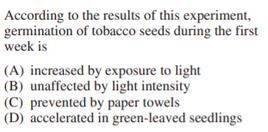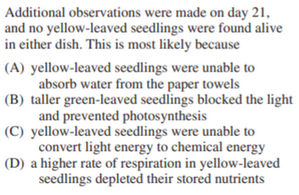10 Hardest AP Biology Practice Questions
What’s Covered:
- How Will AP Scores Impact My College Chances?
- Overview of the AP Biology Exam
- 10 Hardest AP Biology Questions
- Final Tips
This post will cover some of the most difficult AP Biology questions and explain how to ace them. We’ll also give tips on how to study for the exam, what sorts of questions you’ll encounter, and how to space out your time. After reading this post, you’ll be better prepared to score well on the exam!
How Will AP Scores Impact My College Chances?
Colleges don’t typically look at how well you scored on the AP tests to decide your admission. Whether you had all fives or all ones, admissions officers are much more concerned with course rigor and GPA. Taking AP Exams and AP courses are not required by any colleges, even the most selective ones—and it’s important to not take more than you can handle as your grades in those courses will have a large impact on your admission decision. However, colleges like to see that you’re pushing yourself to take challenging courses. This will signal to them that you’re a strong applicant. So taking AP exams is a great way to show you are serious about your academics.
If you do score well on your AP Exam (often times marked at a three or higher), you’ll be able to receive college credit for the course. Some states will only offer credit towards your final degree. For example, you need 120 hours to graduate, the AP Exam will give you three. Other states may give you credit towards a specific course and allow you to take the next course in line, like skipping Biology 101. This can also vary by college.
To see how your current courses affect your chances of getting into your dream school, use our free chancing engine. This tool combines your GPA, course rigor, extracurriculars, demographics, and more to see if your application meets a certain school’s requirements. If it doesn’t, we’ll provide tips and tricks on how to improve it. See your chances at hundreds of schools across the country!
Overview of the AP Biology Exam
Structure
The AP biology exam, like many other AP exams, is made up of two sections: multiple choice and free-response. The multiple choice section has 60 questions whereas the free-response section only has six. Even though this latter section sounds much easier, the questions are complex and require critical thinking. These six questions are further subdivided into two long-answer questions and four short-response questions. Both sections have a time limit of 90 minutes, making the total exam time three hours.
The multiple choice section draws on lecture material and lab scenarios. It is critical to study both of these facets of the course because they appear in both the multiple choice section and the free-response section.
The free response section has two types of questions: long response and short answer. The long-response questions focus on analyzing experimental results. The four short answer questions center on four themes: scientific investigation, conceptual analysis, analysis of model or visual representation, and analysis of data. Lucky for you, they will always be in this order! This way you know what to expect.
The central ideas in the AP biology course are evolution, energetics, information storage and transmission, and systems interaction. These four ideas inform the content of the exam.
Scoring
Each section is worth half of your final grade. The long response questions are worth 8-10 points each and the short-answer questions are worth four points each. The multiple choice questions are each worth one point. Although this scoring seems straightforward, it gets much more complicated:
To find your final score, you multiply your multiple choice score by 1.03, your long-answer score by 1.5, and your short-answer score by 1.43. Sum these products to find your raw score for the AP Biology question score. There are no point deductions for wrong or skipped answers.
To score a three or above, as almost 70% of students do, you need a 52 or higher. The threshold for a five is 92 or above. Only 9.4% of students scored a five in 2020 but this doesn’t mean it’s impossible! Study the AP biology practice questions below to get a feel for what you know and what you don’t.
10 Hardest AP Biology Questions
Multiple Choice
1.
Answer: A
This question seems more complicated than it really is. Talking about denaturing pigment molecules, nutrient deficiency, and camouflage are all important themes but they are meant to distract from the more simple answer that when the genes of the arctic fox that produce a dark coat are blocked by cold temperatures, a white coat results. These are environmental factors on the phenotype of an organism.
When you’re presented with a chart or graph, it will always be accompanied by 4-5 questions. This is an example set of what the non-stand-alone questions look like.
For questions 2-5
2.
Answer: A
Comparing the two petri dishes, the uncovered dish has eight more germinated seeds than the covered dish. This question relies on the student’s ability to understand the data in the chart. The other piece of data that you need is that a week is seven days. With both these in mind, it is obvious that exposure to light helps the seeds to germinate.
3.
Answer: B
Students should use the process of elimination when answering this question. D is wrong because the question states that the seeds are all from the same species. C is also wrong because it asserts that the mean stem length was from light but this dish didn’t get any light. Between answers A and B, A is also incorrect because the cells didn’t get shorter, they got longer. B is correct because the plant was growing because it was searching for light.
4.
Answer: D
To confirm that the cause of the leaf color is genetically controlled, you must look at the data between all the seeds. Because both yellow and green leaves grew in the uncovered dish, it proves that it is not purely a lack of light. A student may conclude that green leaves will only grow with light if they were to solely look at Dish A. If you examine Dish B as well, it shows that both colors of leaves grew.
5.
Answer: C
This is a more complicated question because you have to think critically about what a third week of this experiment would look like. Getting this correct requires the test-taker to understand light energy conversion. Because the yellow leaves have less chlorophyll (by nature of being yellow), they are unable to photosynthesize. Answer B is close to correct but it is wrong because it cites the green leaves as preventing photosynthesis wherein reality we don’t know the actual arrangement of leaves in the experiment.

Free Response
6.
Part A: You should be able to explain how free energy is required for living systems and can predict consequences to these systems if free energy needs are not met. Based on the scenario, you should be able to explain (through narrative or annotated diagrams) the role of electron transport chains.
Part B: You should explain several consequences of viral infections on individual plants. You could predict stunted growth due to lack of energy needed for building molecules or inability to grow and repair tissues due to lack of usable free energy.
Part C: You should be able to explain how a change in one component of a biological system affects the community as a whole with respect to energy flow. You should list both positive and negative effects of short-term change due to viral infection.
Part D: You should be able to predict several potential effects (both positive and negative) for long-term change due to a viral infection on the plant population. These could be how the loss of infected plants reduces the genetic diversity of the grass species or how the loss of prairie grass contributes to erosion.
7.
Part A: You must be able to write a paragraph that represents the frequency of the homozygous straight-wing individuals and that each has two copies of the dominant allele. You must also explain the frequency of the homozygous curly-wing individuals that each has two copies of the recessive allele.
Part B: You must describe one of the following: large population size, no selection, no mutation, no migration, or random mating.
8.
Parts A and B Combined: you must describe two types of data that can be collected. For each of the data, the student explains with justification how the selection of data addresses the question of whether the populations growing above 2,500 meters and the populations growing below 2,500 meters represent a single species. The student should mention interbreeding and producing viable offspring. The student should also identify that the two populations can cross-pollinate and / or germinate seeds.
9.
Part A: the student should answer how the attached ribosome may ultimately end up as a secretory protein excreted from the cell for further use by another cell for cell signaling, signal transduction, or a particular type of metabolic action. They may also say that it may end up embedded into the cell membrane as in integral protein or peripheral protein. The protein will eventually be packed and excreted as a transmembrane protein within the cell.
Part B: The free ribosome may ultimately end up in the cytosol or a vacuole as a structural protein to function in the cytoskeleton or as a motor protein in the cell. The student may also mention that the proteins in the vacuole function as an enzyme that mediates cell processes or as a second messenger in a call signal transduction mechanism. The student would elaborate that the protein would function as a transcription factor or in DNA packaging chromosomes.
10.
Answer: You should be able to write a paragraph that shows an understanding of independent assortment, linkage, and recombination in the transmission or genes from parent to offspring. A prediction of a 1:1:1:1 ratio will be supported by a diagram or Punnett square. The student will be able to use a chi-square analysis and will be able to explain that the genes for body color and eye color are linked on the same chromosome.
Final Tips
To nail all of the AP biology questions, you will need to do more than a simple scan of your notes. The above questions prove that the AP biology exam sources questions from all parts of the course: lecture material, readings, and lab experiences. Only studying your class notes is not enough. If you’re lacking some of these vital resources, we’ve got you covered.
Each multiple choice question has a description filled with useful and useless information. Practice finding which information is necessary in a question. The free-response questions generally don’t try to trip you up like this.
The most important tip is to guess if you don’t know the answer. You won’t lose any points for an incorrect answer, so make sure to bubble in an answer for each one. Although this is a tried and true tip, the best case scenario is to know the right answer. Set up a weekly study plan so that you can internalize the vocab, processes, and question organization.














